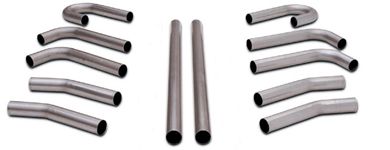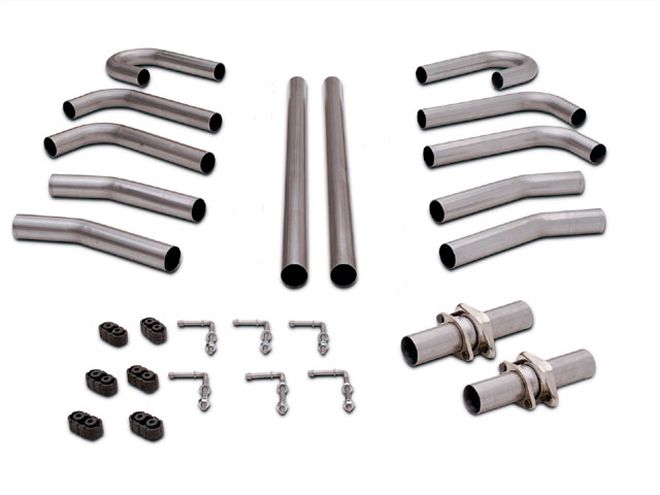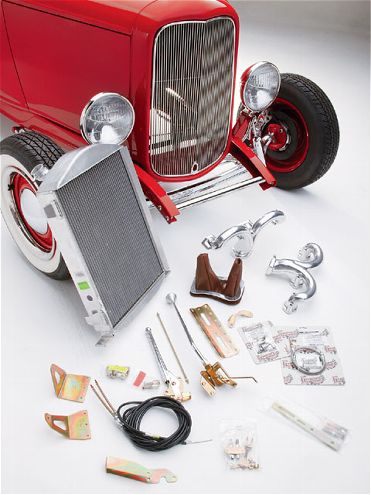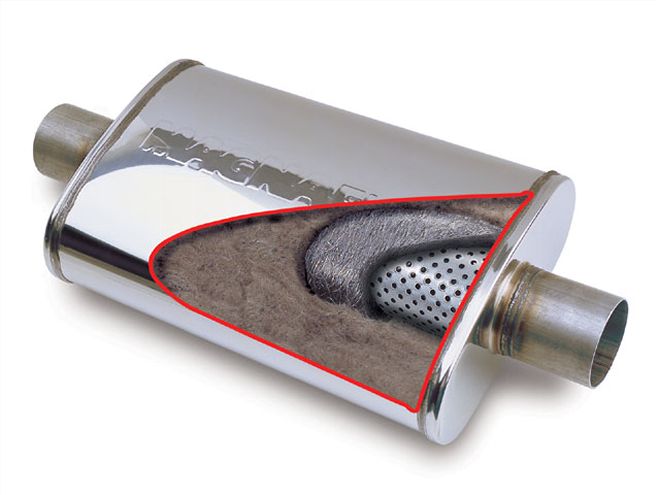
 The MagnaFlow Hot Rod Kit comes in 2.25-, 2.50-, and 3.00-inch-diameter tubing, and the components can be mixed and matched to build your custom exhaust system.
The MagnaFlow Hot Rod Kit comes in 2.25-, 2.50-, and 3.00-inch-diameter tubing, and the components can be mixed and matched to build your custom exhaust system.
Our Speedway Motors Signature Series '32 is nearing completion with one hurdle ahead. This is a simple challenge to overcome given how complete the highboy comes out of the crate-build an exhaust system. And to that end, we paid a visit to MagnaFlow Performance Exhaust, manufacturers of numerous aftermarket exhaust systems for factory rides as well as hot rods. We opted for a MagnaFlow universal-fit Hot Rod Kit.
Remember that we are using the Speedway Motors Tru-Ram (cast iron PN 9300300; polished stainless steel PN 930-0302; natural stainless steel PN 930-0301) exhaust manifolds, which are a center dump. This manifold fits Gen I small-block Chevy engines in a variety of applications. (Make sure to check the Speedway fitment guide to see if your car's original location steering box will work with the Tru-Rams.)

The MagnaFlow Hot Rod Kit comes in 2.25-, 2.50-, and 3.00-inch diameters to meet the performance demands of your engine. The Hot Rod Kit features mandrel-bent universal tubing in various straight and curved sections that will accommodate most custom-built exhaust systems. Mandrel-bent tubing is a term thrown around by many manufacturers, and for good reason. The mandrel-bent tubing creates a smooth, high-flow bend that is pleasing to look at but also allows exhaust gases to escape quickly and easily. The other side of the coin is the compression-bent tubing typically found at the local muffler shop. Compression-bent tubing can significantly limit exhaust gas flow, thereby robbing your engine of its performance (horsepower and torque). To make matters worse, this leads to a loss of fuel economy and can create a an undesirable resonance (sound) in the exhaust note. Our 2.25-inch Hot Rod Kit came with the following:
(2) 54-inch straight lengths
(4) 45 bends
(4) 90 bends
(2) 180 bends
(6) stainless steel hangers
(2) ball and socket flanges
 The cutaway is a 5x8 oval muffler. We used an 18-inch-long pair of these, which comes in a polished stainless steel. The stainless steel body is supported by end caps, a perforated core, and a stainless steel weld bead.
The cutaway is a 5x8 oval muffler. We used an 18-inch-long pair of these, which comes in a polished stainless steel. The stainless steel body is supported by end caps, a perforated core, and a stainless steel weld bead.
In our case, the MAS 350 small-block rated at 325 hp was matched to 2.25-inch exhaust tubing with a pair of 5x8x18 oval O/C mufflers (stainless steel body, end caps, and a perforated core as well as a stainless steel weld bead, and they are reversible for a custom installation). The 2.25-inch polished T304 stainless steel was finished off with round tips (7 inches long with a 3-inch diameter at its opening) to meet the demands of true street performance-drivability and a "throaty" hot rod sound. According to MagnaFlow, the stainless steel tips will last five times longer than chrome tips and come with a lifetime warranty against defects.
Pipe size is always a critical part of the exhaust system matrix. The diameter will affect both sound levels and muffler performance. By now you should also realize that bigger isn't always better. Too large of an exhaust tube can decrease exhaust scavenging by allowing atmospheric pressure to move back upstream (within the pipe). Remember that smaller-diameter exhaust tubing will allow exhaust gases to flow faster than larger tubing, which results in a better scavenging. In the world of street performance, you will find yourself using 2.00- through 2.50-inch pipe, while modified street applications will generally use 2.50- or 3.00-inch pipe. We found ourselves looking at 2.25- to 2.50-inch exhaust tubing in our particular situation and opted to go with the 2.25. Remember that smaller tubing allows exhaust gases to flow faster, enhancing scavenging, and this was high on our desirable character list. Since all-out strip performance wasn't a consideration, let's face it-we have a 2,500lb car with 325 hp, so acceleration shouldn't be a problem ... ever! The smaller-diameter tubing also aided in packaging requirements, allowing us to maximize the space we had to work with underneath.
Follow along and see how you too can fit a custom, high-performance, good-sounding exhaust system to your street rod.